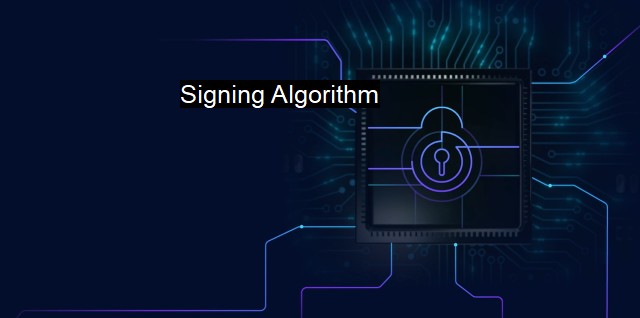What is Signing Algorithm?
The Importance of Signing Algorithms in Cybersecurity and Antivirus Solutions: Verifying Authenticity and Integrity of Digital Data
Signing Algorithms, or digital signature algorithms, as they are more commonly known, are a fundamental aspect of cybersecurity and antivirus technologies. They are cryptographic algorithms used to verify the authenticity and integrity of data, thus playing a crucial role in ensuring data security during transmission over networks and systems.Securing communication is paramount, and this is where the signing algorithm shows its importance. Suppose you plan to transmit a document digitally. In such cases, you'd use a signing algorithm, which works like an electronic safeguard mechanisms, proving that you're indeed the sender and the received document hasn't been tampered with during transmission.
The technology behind a signing algorithm involves two keys: the public key and the private key. The private key is kept secure and confidential by the owner. Meanwhile, the public key is widely distributed and available to everyone in the network. What binds them together is that the keys are mathematically related.
Experts often compare the whole process with sealing a letter before posting. When you use a signing algorithm whilst sending a digital file, it's equivalent to sealing a letter. Even if anyone intercepts your transmission (just as someone might intercept your letter), they can't tamper with it without alerting the recipient. This is because the seal – your digital signature – assures the integrity and authenticity of the document.
When applied within antivirus software, signing algorithms serve to verify the trustworthiness of updates, contributing to their key feature: real-time protection. During an antivirus software update, the software provider will sign off the update package with a private key. The antivirus application installed on the users' server or computer uses the provider's associated public key to verify the authenticity of the updates. Without this crucial cryptography layer, malicious updates could potentially infiltrate these protection systems, leading to extensive security breaches.
Signing algorithms come in various types – with names like RSA, DSA, and ECDSA – each with its benefits and drawbacks. RSA, for instance, is well-regarded due to its security, wide acceptance, and simplicity of implementation. On the other hand, ECDSA shines for its effective digest size that makes it quicker and less resource-intensive. These algorithms serve as a cornerstone in maintaining a secure digital environment, whether in antivirus countermeasures or secured communications.
The usage of signing algorithms is not without challenges. One of the primary issues with these algorithms is key management. The keys in these algorithms need to be kept secure, particularly the private ones. If the private keys are compromised, the whole system's security is jeopardized. This necessity means organizations and individuals employing signing algorithms must have rigorous and robust key management practices to ensure the confidentiality, authenticity, and integrity of data.
As quantum computing technology hastens its pace toward reality, the concern about the potential vulnerability of signing algorithms also grows. Many of today's algorithms may not stand The test of advanced quantum computers, and developing quantum-safe signing algorithms remains a subject of ongoing research and discussion.
Digital signing algorithms represent a cornerstone of cybersecurity architecture and its applications. In antivirus systems, they confirm the authenticity of virus definition updates, safeguarding millions of devices from potential threats. As technology trends evolve, the innovation, development, and application of signing algorithms will continue to be at the heart of forging the future of cyber and data security.

Signing Algorithm FAQs
What is a signing algorithm?
A signing algorithm is a cryptographic technique used in cybersecurity to ensure the authenticity and integrity of digital messages, files, and software. It involves creating a digital signature, which is a unique code that confirms the identity of the sender and verifies that the content has not been altered or tampered with.How does a signing algorithm work in antivirus software?
In antivirus software, a signing algorithm is used to verify the authenticity of software updates and patches before they are downloaded and installed on a user's computer. The algorithm checks the digital signature of the update against a trusted database of signatures to ensure that it comes from a legitimate source and has not been modified by a hacker or malware.What are the benefits of using a signing algorithm in cybersecurity?
The main benefit of using a signing algorithm in cybersecurity is that it helps to protect against unauthorized changes and malicious attacks. By verifying the authenticity of digital messages, files, and software, it allows organizations to maintain the confidentiality, integrity, and availability of their information systems and data. It also helps to build trust between different parties by providing a reliable means of authentication and verification.What are some common signing algorithms used in cybersecurity?
Some of the most commonly used signing algorithms in cybersecurity include RSA, DSA, and ECDSA. These are all asymmetric encryption techniques that use public and private keys to create and verify digital signatures. Other popular algorithms include HMAC, SHA, and MD5, which are used for message authentication and hash functions. The choice of algorithm depends on the specific needs and requirements of the application or system.| | A | | | B | | | C | | | D | | | E | | | F | | | G | | | H | | | I | | | J | | | K | | | L | | | M | |
| | N | | | O | | | P | | | Q | | | R | | | S | | | T | | | U | | | V | | | W | | | X | | | Y | | | Z | |
| | 1 | | | 2 | | | 3 | | | 4 | | | 7 | | | 8 | | |||||||